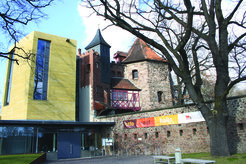
Magdeburg - the City of Otto the Great and Otto von Guericke
With 1200 years of rich and colourful history, Magdeburg is one of the oldest cities in the new federal states of the former East Germany, situated on the Elbe river.
Magdeburg was once an imperial palatinate, a member of the Hanseatic League and a Prussian Fortress which has been marked by unimaginable war and destruction. However, Magdeburg allowed the currents of time to take it into a new future full of possibilities; the city was reconstructed and a particular importance was attached to the maintenance, care and preservation of cultural goods.
Magdeburg was once the cradle of the German Nation. Otto the Great, the first Holy Roman Emperor, made Magdeburg his favourite palatine, commissioned the erection of a mighty cathedral as well as elevated the city into an Archbishopric despite all opposition. The city shaped up to become a centre of the Christian occident where Magdeburg was home to the Oberhof, a supreme authority which played a major role in the history of medieval legislation.

Martin Luther preached in Magdeburg where he turned the city into an important protestant stronghold; Otto von Guericke invented the air pump as well as discovered the vacuum; the Baroque composer Telemann wrote his first opera in Magdeburg; the engineer Hermann Gruson introduced chilled cast iron products, a breathtaking development in mechanical engineering; Hans Grade carried out the first German motorised flight attempt in the Cracauer Anger area and the engineer Rudolf Nebel made first attempts to promote the launch of a rocket with a human passenger on board.
Magdeburg has shaped up to become a thriving business location as well as a centre of science and research enjoying nationwide importance. Located at the heart of an important business region, Magdeburg has emerged as a vibrant hub of trade and services while at the same time providing for an attractive scientific landscape where an impressive research and science infrastructure has developed around the Otto von Guericke University and the University of Applied Sciences Magdeburg-Stendal. About 18000 young people study in Magdeburg where they particularly appreciate the close relationship between theory and practice as well as enjoy the hustle and bustle of a big city.
Most popular attractions in Magdeburg
The Magdeburg Cathedral, dedicated to St. Maurice and St. Catherine, (Dom St. Mauritius und Katharina) is the first Gothic-style cathedral to be constructed on German soil, one of the largest church buildings in Germany and the most famous attraction in Magdeburg. The origins of the cathedral can be traced back to the year 937, when Emperor Otto the First founded a monastery and dedicated it to St. Maurice.

The Green Citadel of Magdeburg (Grüne Zitadelle / Hunderwasserhaus) is one of Magdeburg’s most eye-catching attractions and is also one of the last architectural masterpieces designed by the artist Friedensreich Hundertwasser. The Hundertwasser Building is located among a mixture of Baroque facades and examples of modern design and provides the Breiter Weg with yet another landmark in the form of an imaginative construction injecting a burst of colourful culture. The Green Citadel of Magdeburg was officially inaugurated in October 2005.
The Art Museum in the Monastery of Our Lady (Kunstmuseum Kloster Unser Lieben Frauen) is the most important venue for contemporary art and sculpture in the German Land of Saxony-Anhalt. The unique well-house, magnificent barrel-vaults and sublime monastery church with its slender towers all make up an architectural marvel which is the centrepiece of all Romanesque buildings in Saxony-Anhalt. The Romanesque building hosts both the Magdeburg Art Museum and the Georg Philipp Telemann concert hall.
Thanks to its outstanding medieval exhibitions, the Magdeburg Cultural History Museum (Kulturhistorisches Museum) has become famous far beyond the state of Saxony-Anhalt. Located in the same building you will find the Museum of Nature.

The Guericke-Zentrum (Otto-von-Guericke-Museum /) Lukasklause is situated within the old walls of the Lukasklause building, which boasts an octagonal tower that was first mentioned in the 14th century. You can view historic replicas, pictures and documents, as well as live experiments, that will give you an insight into the life and work of Otto von Guericke (1602-1686). The Guericke Centre was opened in 2010.
The cultural landscape of the Elbauenpark, which is home to the Millennium Tower (with 250 exhibits and artefacts taking you on an interactive insight into over 6000 years of human, technical and scientific development), Lake Stage, Butterfly House and a number of playgrounds, sports areas, pieces of art, themed gardens and many other attractions, provides a popular location for leisure activities.
The diversified theatre world of Magdeburg and a wide variety of events promise plenty of excitement and cultural highlights, first of all the Magdeburg theatre and the opera house, as well as the puppet theatre and two cabarets. In addition, unforgettable performances by free theatre ensembles mounted in picturesque villas or set in historical contexts complete the offer.


